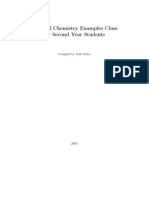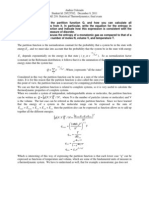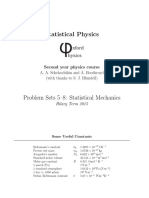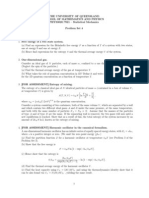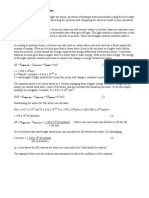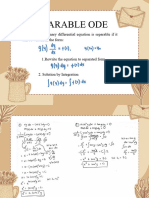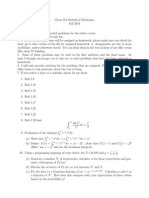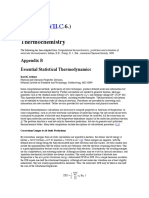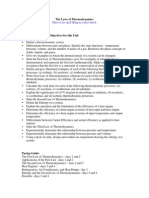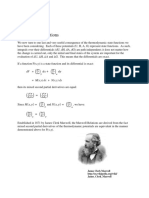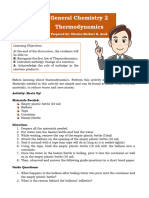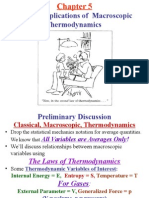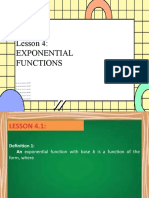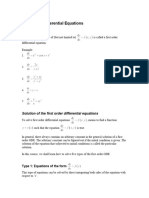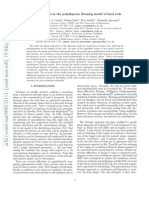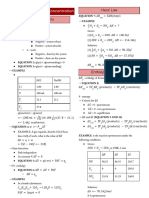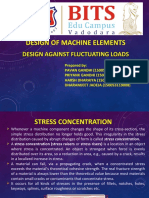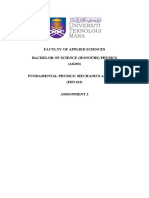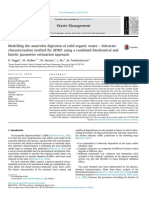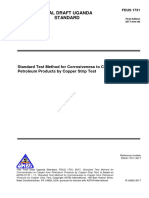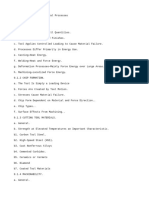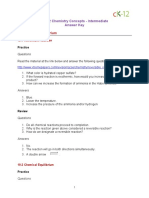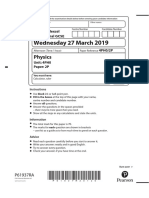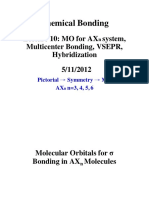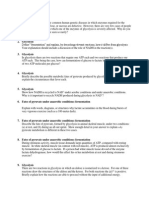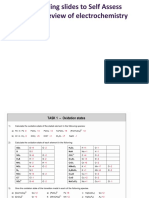07 Midterm
07 Midterm
Uploaded by
Gilberto RuizCopyright:
Available Formats
07 Midterm
07 Midterm
Uploaded by
Gilberto RuizCopyright
Available Formats
Share this document
Did you find this document useful?
Is this content inappropriate?
Copyright:
Available Formats
07 Midterm
07 Midterm
Uploaded by
Gilberto RuizCopyright:
Available Formats
MIDTERM EXAM, PHYSICS 5305, Spring, 2007, Dr. Charles W.
Myles Take Home Exam: Distributed, Wednesday, March 21 DUE, IN MY OFFICE OR MAILBOX, 5PM, WED., MARCH 28.
NO EXCEPTIONS! EXAM RULE: You are allowed to use almost any resources (library books, etc.) to solve these
problems. EXCEPTION: You MAY NOT COLLABORATE WITH ANY OTHER PERSON in solving them! If you have questions or difficulties with the problems, you may consult with me, but not with fellow students (whether or not they are in this class!), with other faculty, or with post-docs. You are bound by the TTU Code of Student Conduct not to violate this rule! Anyone caught violating this rule will, at a minimum, receive an F on this exam! INSTRUCTIONS: Read all of these before doing anything else!!! Failure to follow them may lower your
grade!!
1. PLEASE write on ONE SIDE of the paper only!! This wastes paper, but it makes my grading easier! 2. PLEASE do not write on the exam sheets, there will not be room! Use other paper!! 3. PLEASE show all of your work, writing down at least the essential steps in the solution of a problem.
Partial credit will be liberal, provided that the essential work is shown. Organized work, in a logical, easy to follow order will receive more credit than disorganized work. 4. PLEASE put the problems in order and the pages in order within a problem before turning in this exam! 5. PLEASE clearly mark your final answers and write neatly. If I cannot read or find your answer, you can't expect me to give it the credit it deserves and you are apt to lose credit. 6. NOTE: The words EXPLAIN and DISCUSS mean to do this briefly, using complete,
grammatically correct English sentences! 7. NOTE!!! The setup (THE PHYSICS) of a problem will count more heavily in the grading than the
detailed mathematics of working it out.
PLEASE FOLLOW THESE SIMPLE DIRECTIONS!!!! THANK YOU!!! NOTE!!!! YOU MUST ANSWER PROBLEM 1! WORK ANY 5 OUT OF THE OTHER 6 PROBLEMS! So, you must answer 6 problems in total. Problem 1 is worth 10 points. Each of the others is equally weighted and worth 18 points. So, 100 is the maximum points possible. Please sign this statement and turn it in with your exam: I have neither given nor received help on this exam _______________________________
Signature
1. THIS QUESTION IS REQUIRED!!
a. A coin is tossed 400 times. Find the probability of obtaining 215 heads. Use the Gaussian approximation. b. Write the 1st Law of Thermodynamics for an infinitesimal, quasi-static process in a system characterized by absolute temperature T and one external parameter x. EXPLAIN the physical meaning of every symbol you write and DISCUSS the physical meaning of the law itself. c. Write the 2nd Law of Thermodynamics for the system of part a. EXPLAIN the physical meaning of every symbol you write and DISCUSS the physical meaning of the law itself. d. Write the 3rd Law of Thermodynamics for system in part a. EXPLAIN the physical meaning of every symbol you write and DISCUSS the physical meaning of the law itself. e. DISCUSS the physical meaning of entropy. f. State the Fundamental Postulate of Statistical Mechanics. DISCUSS its physical meaning and some of its consequences.
NOTE!!!! WORK ANY 5 OUT OF PROBLEMS 2 through 7! 2. The number of accessible states for a system of N particles confined to volume V and with energy in the range E to E + E is given by (E,V,N) = AE(7N/3)exp[BNV(3/5)E] where A & B are constants. a. Calculate the entropy in terms of E,V and N. b. The absolute temperature of the system is T. Calculate the internal energy E as a function of T,V, and N. c. Find the equation of state P(V,T,N) for this system, where P is the pressure. d. Calculate the heat capacity CV,N at constant volume V and constant particle number N for this system. Express this as a function of N & V only. e. Calculate the volume coefficient of expansion and the isothermal compressibility for this system. (See Reif, Ch. 5) f. Calculate the heat capacity CP,N at constant pressure P and constant particle number N for this system. Express this as a function of N & V only. 3. Consider a classical simple harmonic oscillator in one dimension. The total energy is written as E = (p2/2m) + ()kx2. p is the particle momentum, x is its position, k is the spring constant. a. For fixed energy E, sketch the allowed region in classical phase space (the x-p plane) that is accessible to the oscillator for all energies less than or equal to E. If the energy is in the very small range E to E + E, sketch (on the same figure you just sketched) the allowed region of phase space that it accessible to the oscillator. b. For k = 2 N/m, m = 2 kg, and amplitude xm = 3 m, calculate the number of allowed states for this oscillator for all energies less than or equal to E. Take the area of the cell in phase space to be Plancks constant h. Put in NUMBERS! I want a NUMERICAL VALUE! c. Suppose the position x of the oscillator is changed a small amount to x + x, while the momentum p is unchanged. Find an expression for the corresponding change in energy E, in this case. For x = 0.01 m, NUMERICALLY calculate E for the oscillator of part b. Use this result to NUMERICALLY calculate the number of accessible states in the range E to E + E, for this same oscillator. d. Using the quantum mechanical expression for the energy E of the same simple harmonic oscillator in part b, estimate the quantum number n. Compare this result to that of part b. 4. A substance has the following properties (A,B,V0,T0, and a are constants): i) At constant temperature T0, the work done by it on expansion from volume V0 to volume V is W0 = 5A(T0)3ln(V/V0) ii) The entropy is given by S = B(V0/V)2(T/T0)a a. Calculate the change in Helmholtz free energy F = F(T,V) F(T0,V0) in taking the system from temperature T0 and volume V0 to temperature T and V. b. Find the equation of state. c. Calculate the work done on expansion from volume V0 to volume V at arbitrary temperature T. NOTE!!!! WORK ANY 5 OUT OF PROBLEMS 2 through 7! 5. Consider the chemical reaction A + B C. The molar heat capacities (in units of [J/(mole-K)]) at
constant pressure of substances A,B, and C are the following functions of absolute temperature T by: CA = 5T, CB = 8T, CC = 15T. This reaction is carried out at constant temperature T = 300K. a. Calculate the entropy change per mole, S, of substance C produced. Does the sign of your answer violate the 2nd Law of Thermodynamics? If not, why not? EXPLAIN briefly using complete, grammatically correct English sentences. b. Calculate the heat released per mole, Q, of substance C produced. c. Assuming that the mechanical work, W, done in this reaction is zero, calculate the total change in internal energy per mole E produced in this reaction. 6. Consider a system of total charge q in a static electric field, which is characterized by an electrostatic potential . The system is in thermal equilibrium at absolute temperature T. Consider an infinitesimal, quasi-static process in which the electrostatic potential is changed by d. Recall that, in such a situation, the mechanical work done is - qd. For this system, use the following definitions (E is the internal energy, S is the entropy): Enthalpy: H = E - q, Helmholtz Free Energy: F = E TS, Gibbs Free Energy: G = E TS - q. In solving this problem PLEASE be VERY CAREFUL in your partial derivative notation about which variables are held constant when the derivative is taken. a. Write, in differential form, involving the differential dE, the combined 1st & 2nd Laws of Thermodynamics for this system, assuming that the entropy S and the electrostatic potential U are independent variable. b. Use the properties of differentials and the results of part a to express T and q as partial derivatives of E. c. Use the properties of partial derivatives and the results of part b to relate an appropriate partial derivative of q to a partial derivative of T, hence deriving one of Maxwells relations for this system. d. Repeat parts a,b,c, except begin by writing the combined 1st and 2nd Laws in terms of a differential of F, assuming T and are independent variables and expressing S and q as appropriate partial derivatives of F. e. Repeat parts a,b,c, except begin by writing the combined 1st and 2nd Laws in terms of a differential of H, assuming S and q are independent variables and expressing T and as appropriate partial derivatives of H. f. Repeat parts a,b,c, except begin by writing the combined 1st and 2nd Laws in terms of a differential of G, assuming T and q are independent variables and expressing S and as appropriate partial derivatives of G.
NOTE!!!! WORK ANY 5 OUT OF PROBLEMS 2 through 7! 7. Consider a mole of steam under high pressure, so that the Van der Waals equation is the proper equation of state. Van der Waals constants for steam: a = 4.0 (liter)2atm/(mole)2 b = 0.5 liter/mole. It is initially at pressure Pi = 50 atm and has volume Vi = 0.5 liter. It is then
expanded to twice that volume. a. Calculate the initial temperature of the steam. b. If the expansion is isobaric (at constant pressure), calculate the final temperature. c. Calculate the mechanical work (in Joules) done in the isobaric expansion of part b. d. If the expansion is isothermal (at constant temperature), calculate the final pressure. e. Calculate the mechanical work (in Joules) done in the isothermal expansion of part d. For parts f and g ONLY, assume that the ideal gas law holds, but that = cp/cv = 1.96. f. Calculate the final temperature and pressure if the expansion is adiabatic (at constant entropy). g. Calculate the mechanical work (in Joules) done in the adiabatic expansion of part f.
You might also like
- Thermo HW SolsDocument61 pagesThermo HW Solsbra5100% (1)
- Merzbach Er So LsDocument605 pagesMerzbach Er So LsJohn Holman100% (1)
- Hello World!: Here Is Where Your Presentation BeginsDocument45 pagesHello World!: Here Is Where Your Presentation BeginsHà Dung NguyễnNo ratings yet
- Noon,: Tuesday, May 14!! No Exceptions!Document3 pagesNoon,: Tuesday, May 14!! No Exceptions!samiNo ratings yet
- Fizkem Seminar ExDocument22 pagesFizkem Seminar ExZsolt Dürvanger100% (1)
- Homework 2 Solutions CHEMISTRYDocument5 pagesHomework 2 Solutions CHEMISTRYshaframenNo ratings yet
- AdvThermo PS01 2013 SolnDocument14 pagesAdvThermo PS01 2013 SolnPraveen P JoseNo ratings yet
- All Master File Problem Set Statistical Mechanics June 2010 To Current 05 2014 PDFDocument15 pagesAll Master File Problem Set Statistical Mechanics June 2010 To Current 05 2014 PDFsamiNo ratings yet
- All Master File Problem Set Statistical Mechanics June 2010 Thru Jan 2017 DMDocument26 pagesAll Master File Problem Set Statistical Mechanics June 2010 Thru Jan 2017 DMCassiaNo ratings yet
- ChE211 F15 HW4Document1 pageChE211 F15 HW4ali_b1367No ratings yet
- Final Exam 216 AFCDocument8 pagesFinal Exam 216 AFCDré ColoradoNo ratings yet
- Thermodynamic Calculus ManipulationsDocument5 pagesThermodynamic Calculus ManipulationsAnshu Kumar GuptaNo ratings yet
- The State of A Gas or A Liquid at EquilibriumDocument12 pagesThe State of A Gas or A Liquid at EquilibriumDrRat P RatanamalayaNo ratings yet
- Statistical Physics: Xford HysicsDocument21 pagesStatistical Physics: Xford HysicsasdNo ratings yet
- Lecture-Titulaer OxfordDocument20 pagesLecture-Titulaer OxfordHa GreinnerNo ratings yet
- Good Luck : Sample Final Exam QuestionsDocument5 pagesGood Luck : Sample Final Exam QuestionsROMULO CUBIDNo ratings yet
- Problem Set 4Document2 pagesProblem Set 4chrisray39No ratings yet
- Rich ThinkingDocument17 pagesRich ThinkingMain AccountNo ratings yet
- Homework 2Document2 pagesHomework 2lux0008No ratings yet
- HW 5Document2 pagesHW 5yash bhagwatNo ratings yet
- 2021 CIR310 Sem Test 2 With AnswersDocument13 pages2021 CIR310 Sem Test 2 With Answersu21589969No ratings yet
- Homework 2 SolutionDocument6 pagesHomework 2 SolutionMeirielle MarquesNo ratings yet
- HW1Document2 pagesHW1Adane SamuelNo ratings yet
- SpecSimVR MEGDocument6 pagesSpecSimVR MEGMatthew GarnerNo ratings yet
- Experiment 8 Hydrogen SpectrumDocument4 pagesExperiment 8 Hydrogen SpectrumNadillia SahputraNo ratings yet
- Gas Law ActivityDocument7 pagesGas Law Activitydaniel tabuzoNo ratings yet
- Thermoprob 3Document2 pagesThermoprob 3jadgug0% (1)
- Due Date: 25 October 2016: EX EX EXDocument3 pagesDue Date: 25 October 2016: EX EX EXNilNo ratings yet
- MM 651 PS-1Document1 pageMM 651 PS-1DeepakNo ratings yet
- Lecture 04 Oneside PDFDocument9 pagesLecture 04 Oneside PDFMrsriyansyahNo ratings yet
- EUF Joint Entrance Examination For Postgraduate Courses in PhysicsDocument6 pagesEUF Joint Entrance Examination For Postgraduate Courses in PhysicsAndersson De La CruzNo ratings yet
- Tutorial 4 PDFDocument4 pagesTutorial 4 PDFAmeyNo ratings yet
- Science 10 Las 4-1Document5 pagesScience 10 Las 4-1Michael TuyayNo ratings yet
- Physical Chemistry ExamDocument5 pagesPhysical Chemistry ExamelnurorucluNo ratings yet
- Szabo Ostlund Ex 1.19Document7 pagesSzabo Ostlund Ex 1.19ma_hedNo ratings yet
- 04 - Effect - of - Temperature Spring2022Document7 pages04 - Effect - of - Temperature Spring2022Pfano MarandelaNo ratings yet
- Midterm ExaminationDocument7 pagesMidterm Examinationabcdefghij500No ratings yet
- Statistical PhysicsDocument21 pagesStatistical PhysicsSaswata RoyNo ratings yet
- GP1 - Q2 - Week 7Document6 pagesGP1 - Q2 - Week 7Shekaina Faith Cuizon Lozada100% (1)
- Ambol ENS181Document49 pagesAmbol ENS181huozniearindigNo ratings yet
- AssignmentsDocument10 pagesAssignmentsDQZNo ratings yet
- Problems For Computational ChemistryDocument15 pagesProblems For Computational ChemistryMohamed Ayman MoshtohryNo ratings yet
- .2. (. .6.) Thermochemistry: I D VII CDocument14 pages.2. (. .6.) Thermochemistry: I D VII CEdgar JuarezNo ratings yet
- Thermodynamics For PRINTDocument17 pagesThermodynamics For PRINTJerico LlovidoNo ratings yet
- Statistical Mechanics: Alejandro L. GarciaDocument133 pagesStatistical Mechanics: Alejandro L. GarciaAnonymous YEDUXNNo ratings yet
- TDA 301T-8c - Thermodynamic Properties Real SubstancesDocument127 pagesTDA 301T-8c - Thermodynamic Properties Real SubstancesPortia ShilengeNo ratings yet
- Determination of Spring ConstantDocument5 pagesDetermination of Spring Constantleonardo.sardagnaNo ratings yet
- The Maxwell Relations: CHEM 331 Physical Chemistry Fall 2017Document11 pagesThe Maxwell Relations: CHEM 331 Physical Chemistry Fall 2017AhmedovicMichaelNo ratings yet
- Thermodynamics ModuleDocument6 pagesThermodynamics ModulebuenafefloresNo ratings yet
- Simple Applications of Macroscopic ThermodynamicsDocument33 pagesSimple Applications of Macroscopic ThermodynamicsreianreyNo ratings yet
- Exploring Enthalpy Entropy and Free EnergyDocument8 pagesExploring Enthalpy Entropy and Free Energynoobiekids2016No ratings yet
- Introducton To ThermodynamicsDocument7 pagesIntroducton To Thermodynamicsdesi_parisNo ratings yet
- Thermal Physics Lecture 11Document8 pagesThermal Physics Lecture 11OmegaUserNo ratings yet
- Lesson 4 Exponential FunctionDocument38 pagesLesson 4 Exponential FunctionAlfred Fegalan100% (1)
- CQEx 95 S SMDocument2 pagesCQEx 95 S SMفارس الزهريNo ratings yet
- Free Energy Part I 2015Document3 pagesFree Energy Part I 2015gogogoreaperNo ratings yet
- Thermodynamic Variables Versus Microscopic VariablesDocument6 pagesThermodynamic Variables Versus Microscopic Variablesanon_251774No ratings yet
- 1st Order ODE (Notes)Document25 pages1st Order ODE (Notes)i21020652No ratings yet
- MMC ProblemsDocument473 pagesMMC ProblemsGilberto RuizNo ratings yet
- Quantizing The Electromagnetic Field Without Frills: SupplementDocument8 pagesQuantizing The Electromagnetic Field Without Frills: SupplementGilberto RuizNo ratings yet
- Phase Equilibria in The Polydisperse Zwanzig Model of Hard RodsDocument14 pagesPhase Equilibria in The Polydisperse Zwanzig Model of Hard RodsGilberto RuizNo ratings yet
- T 0 0 T T 0 at BTDocument1 pageT 0 0 T T 0 at BTGilberto RuizNo ratings yet
- Chem 26 ReviewerDocument8 pagesChem 26 ReviewermattyrodrigoNo ratings yet
- (PDF) Text Section 28.3 Kirchhoff's Circuit RulesDocument8 pages(PDF) Text Section 28.3 Kirchhoff's Circuit RulesFernando GandaNo ratings yet
- Fenomenos Taller de GasesDocument20 pagesFenomenos Taller de GasesDavid MontoyaNo ratings yet
- Design of Machine Elements Design Against Fluctuating LoadsDocument39 pagesDesign of Machine Elements Design Against Fluctuating LoadsAwan AJaNo ratings yet
- Phy433 Assignment 2Document18 pagesPhy433 Assignment 2Michael McBertNo ratings yet
- Safety Data Sheet: 1. Identification of The Substance/Preparation and of The Company/UndertakingDocument10 pagesSafety Data Sheet: 1. Identification of The Substance/Preparation and of The Company/UndertakingAdalbert RinconNo ratings yet
- Q4 - Science5 - Week 2Document14 pagesQ4 - Science5 - Week 2Maria Ronavie Davalos MantesNo ratings yet
- POGGIO - 2016 - Modelling The Anaerobic Digestion of Solid Organic Waste - SubstrateDocument15 pagesPOGGIO - 2016 - Modelling The Anaerobic Digestion of Solid Organic Waste - SubstrateThobiasNo ratings yet
- Nutrient Solution 2Document21 pagesNutrient Solution 2MAditaPutra100% (2)
- Materia OrganicaDocument2 pagesMateria OrganicaVictor Hugo DelgadilloNo ratings yet
- Unit 7 Questions OnlyDocument58 pagesUnit 7 Questions Onlyyoomin2005824No ratings yet
- Astm D1838Document13 pagesAstm D1838Orlando AguirreNo ratings yet
- 400 00030953en Engage 8180 TdsDocument3 pages400 00030953en Engage 8180 TdsSIDDHARTH BHASNEYNo ratings yet
- Chapter 9. Material Removal ProcessesDocument4 pagesChapter 9. Material Removal ProcessesBinhNo ratings yet
- Chem Int CC CH 19 - Equilibrium - Answers PDFDocument12 pagesChem Int CC CH 19 - Equilibrium - Answers PDFChristal EcheverriaNo ratings yet
- Chemistry A European J - 2017 - Shimizu - Silicone Based Organic Inorganic Hybrid Aerogels and XerogelsDocument12 pagesChemistry A European J - 2017 - Shimizu - Silicone Based Organic Inorganic Hybrid Aerogels and XerogelsKUMAR GHOSHNo ratings yet
- Practice Guide-ElectrostaticsDocument27 pagesPractice Guide-ElectrostaticsRokas KibelisNo ratings yet
- Adstefan Input Data SheetDocument4 pagesAdstefan Input Data SheetMuthu KumarNo ratings yet
- 2709-Article Text-11414-1-10-20180902Document10 pages2709-Article Text-11414-1-10-20180902Dimitris DountsisNo ratings yet
- BP 304 T. Pharmaceutical Engineering (Theory) Unit Iii: B. Pharm. Third SemesterDocument33 pagesBP 304 T. Pharmaceutical Engineering (Theory) Unit Iii: B. Pharm. Third SemesterArghadeep BhattacharjeeNo ratings yet
- 2P Jan 19Document22 pages2P Jan 19Snip x Hunt manNo ratings yet
- Group Theory Notes - Compressed-1-1Document69 pagesGroup Theory Notes - Compressed-1-1Raj kumarNo ratings yet
- Green ChemistryDocument27 pagesGreen ChemistryMonika11Sharma100% (1)
- H&MT - Lesson 5. Electrical Analogy and Numerical Problems Related To ConductionDocument5 pagesH&MT - Lesson 5. Electrical Analogy and Numerical Problems Related To ConductionadimeghaNo ratings yet
- CHE332 - Introduction To Environmental Engineering CHAPTER 1 - IntroductionDocument17 pagesCHE332 - Introduction To Environmental Engineering CHAPTER 1 - Introductionazzatul amiraNo ratings yet
- Ciba Irgalube 63: Extreme Pressure / Antiwear AdditiveDocument8 pagesCiba Irgalube 63: Extreme Pressure / Antiwear AdditiveRaj Aryan YadavNo ratings yet
- Methods For The Determination of Limit of Detection and Limit of Quantitation ofDocument15 pagesMethods For The Determination of Limit of Detection and Limit of Quantitation ofAshraf ShaikhNo ratings yet
- Cau Hoi On Tap Glycolysis + Gluconeogenesis + PP PathwayDocument4 pagesCau Hoi On Tap Glycolysis + Gluconeogenesis + PP Pathwaynhocnho_1993No ratings yet
- Edited L2 - Electrochemical-Cells - LWi - NEWDocument40 pagesEdited L2 - Electrochemical-Cells - LWi - NEWIan FernandezNo ratings yet




